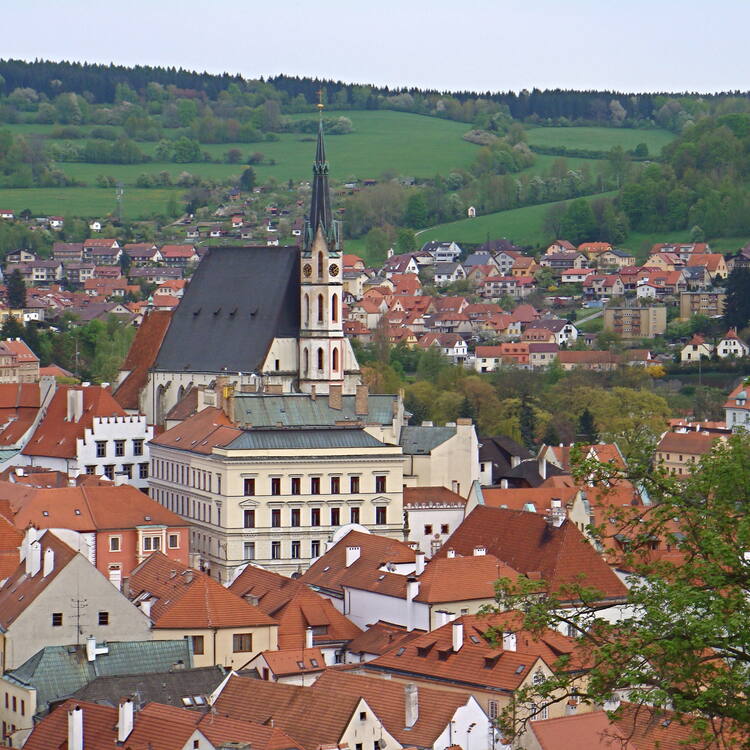Historic Centre of Český Krumlov
Historic Centre of Český Krumlov
Situated on the banks of the Vltava river, the town was built around a 13th-century castle with Gothic, Renaissance and Baroque elements. It is an outstanding example of a small central European medieval town whose architectural heritage has remained intact thanks to its peaceful evolution over more than five centuries.
Description is available under license CC-BY-SA IGO 3.0
Centre historique de Český Krumlov
Sur les rives de la Vltava, cette ville a été édifiée autour d'un château du XIIIe siècle comportant des éléments gothiques, Renaissance et baroques. C'est un exemple exceptionnel de petite ville médiévale d'Europe centrale qui s'est développée paisiblement pendant cinq siècles, conservant ainsi un patrimoine architectural intact.
Description is available under license CC-BY-SA IGO 3.0
وسط تشسكي كروملوف التاريخي
شُيدت هذه المدينة على ضفاف نهر فلتافا حول قصر يرقى الى القرن الثالث عشر ويتضمن عناصر تنتمي الى الفن القوطي وفن عصر النهضة وفن الباروك. وتشكل المدينة مثالاُ فريداً للمدينة الصغيرة التي نشأت في أوروبا الوسطى في القرون الوسطى ونمت بهدوء طيلة خمسة قرون، مع حفاظها على تراث معماري لم يمس.
source: UNESCO/CPE
Description is available under license CC-BY-SA IGO 3.0
克鲁姆洛夫历史中心
这个城镇位于瓦尔塔瓦河(Vltava river)畔,围绕一座13世纪城堡而建。这座城堡融合了哥特式、文艺复兴式以及巴洛克式风格。这是中世纪中欧小城的杰出典范,经历五个多世纪的和平发展,其建筑古迹被原封不动地保留了下来。
source: UNESCO/CPE
Description is available under license CC-BY-SA IGO 3.0
Исторический центр города Чески-Крумлов
Город на берегах реки Влтавы возник вокруг замка XIII в., сочетающего элементы готики, Возрождения и барокко. Это выдающийся пример небольшого средневекового центральноевропейского города, архитектурное наследие которого сохранилось благодаря мирному развитию в течение пяти столетий.
source: UNESCO/CPE
Description is available under license CC-BY-SA IGO 3.0
Centro histórico de Český Krumlov
Situada a orillas del río Moldava, esta ciudad se edificó en torno a un castillo del siglo XIII que posee elementos arquitectónicos de estilo gótico, renacentista y barroco. Český Krumlov es un ejemplo de pequeña ciudad medieval de Europa Central único en su género, ya que su apacible desarrollo ha permitido conservar intacto su patrimonio por espacio de más de cinco siglos.
source: UNESCO/CPE
Description is available under license CC-BY-SA IGO 3.0
チェスキー・クルムロフ歴史地区
source: NFUAJ
Historisch centrum van Český Krumlov
Český Krumlov ligt aan de oevers van de rivier de Moldau en werd gebouwd rond een 13e-eeuws kasteel met gotische, renaissance en barok elementen. Het is een goed voorbeeld van een kleine Centraal-Europese middeleeuwse stad, waarvan het architectonisch erfgoed intact is gebleven dankzij een vreedzame ontwikkeling gedurende meer dan vijf eeuwen. Český Krumlov heeft twee belangrijke historische gebieden: het Latran gebied onder het kasteel en de stad aan de overkant, in de bocht van de Moldau. De stad heeft een regelmatig, typisch middeleeuws stratenplan, met straten die uitlopen vanuit het centrale plein en een ronde weg tussen de stadsmuren.
Source: unesco.nl
Outstanding Universal Value
Brief synthesis
The town of Český Krumlov is located in the South Bohemian Region of the Czech Republic. Situated on both banks of the Vltava (Moldau) river, the town was built below a magnificent castle founded in the 13th century. The river meander and rocky slopes of the castle hill are the most important elements which along with the link to the picturesque neighbouring landscape, determine not only the impressive urban composition of the historic centre but the dominating position of the castle as well.
The Historic Centre of Český Krumlov is an outstanding example of a small Central European medieval town whose architectural heritage has remained intact thanks to its peaceful evolution over more than several centuries. This feudal town, a former centre of a large estate owned by powerful noble families who played an important role in the political, economic and cultural history of Central Europe, was founded in the Middle Ages and underwent Renaissance and Baroque transformations. As it remained almost intact, it has retained its street layout, which is typical of planned medieval towns, as well as many historic buildings including their details such as the roof shapes, the decoration of Renaissance and Baroque facades, vaulted spaces, as well as original layouts and interiors.
The castle features Gothic, Late Gothic, Renaissance and Baroque elements. It is dominated by the Gothic Hrádek with its round tower; this was subsequently converted into a Baroque residence with the addition of a garden, the Bellaire summer pavilion, a winter riding school, and a unique Baroque theatre in 1766. Latrán (settlement developed to the east) and the town proper contain undisturbed ensembles of burgher houses, the oldest being in High Gothic style. They are notable for their facades, internal layouts, and decorative detail, and especially carved wooden Renaissance ceilings. Český Krumlov also experienced considerable ecclesiastical development illustrated by the major 15th century church of St. Vitus and monasteries of various preaching and itinerant orders.
Criterion (iv): Český Krumlov is an outstanding example of a Central European small town dating from the Middle Ages which owes the structure and buildings of its historic core to its economic importance and relatively undisturbed organic development over some five centuries. Český Krumlov grew up within a meander of the Vltava River, which provides a natural setting of great beauty. Its evolution over time is evident with startling clarity from its buildings and its urban infrastructure.
Integrity
All key elements conveying the Outstanding Universal Value of this property are inside the boundaries of the property. The property includes the historic centre of the town including the former aristocratic residence with an extensive garden. Its delimitation and size are appropriate. The buffer zone is well delimited too. The structure of the land use plan of the property and its buffer zone is stabilized. The visual integrity of the town is not threatened. Nevertheless, the pressure to allow new construction beyond the boundaries of the buffer zone is a potential danger to the integrity of the property.
Authenticity
The Historic Centre of Český Krumlov is a property of high authenticity. Its present form and appearance closely reflect the type of a town linked to the noble residence since the Middle Ages. The historic centre has preserved its original layout, as well as the characteristic castle-city relationship very clearly, thanks to its undisturbed development over several centuries. It remains untouched by the devastating effects of 19th-century industrialization, neglect during the communist era and thoughtless developments of the past decades. The high degree of authenticity is based on the dramatic setting of the urban townscape and its natural environment, as well as on a large number of preserved historic details. Restoration works on the facades of the buildings are carried out in compliance with strict international standards for heritage conservation. Only traditional materials and techniques are used.
Protection and management requirements
The Historic Centre of Český Krumlov is protected by Act No. 20/1987 on State Heritage Preservation as amended, as an urban conservation area (urban heritage reservation according the Act). The castle with the garden and a Parish church inside the historic centre are designated as national cultural heritage sites (under the Act mentioned above and under the relevant regulations); hence they enjoy the highest degree of legal protection. In addition, the historic centre includes several dozens of buildings that are designated as cultural heritage sites under the Act mentioned above. From a legal point of view, the protection of the buffer zone is strengthened by the fact that the Plešivec urban heritage zone is situated within its boundaries. The pressure to allow new construction in the buffer zone is regulated by the Act mentioned above and by the valid Land Use Plan, which stabilizes the functions of plots and areas within the whole town of Český Krumlov; that means property and its buffer zone. All specific details of building projects (new structures, their volumes and heights) are the subject of consideration by relevant authorities.
The responsibility for the property management is shared by the National Heritage Institute (a state organization) and the Municipality of Český Krumlov. Due to the extent of the property and its complicated ownership structure, maintenance and restoration of the various properties are subject to individual programmes that are coherent with the Programme for the Regeneration of Urban Heritage Reservations and Zones. Phase 4 of the Management Plan has been prepared in 2012, representing an up-date of the E- Management Plan. The main purpose of the Management Plan is to preserve the Outstanding Universal Value of the property. Since the beginning (2009), the document has been planned to apply to both key elements of the Municipal Heritage Site, the castle complex and the historic center.
Financial instruments for the conservation of the property mainly include grant schemes, funding through the programme of the Ministry of Culture of the Czech Republic allocated to the maintenance and conservation of the immovable cultural heritage and of areas under heritage preservation, as well as financial resources allocated from other public budgets. Since 2000, annual monitoring reports have been prepared at the national level to serve the World heritage property manager, the Ministry of Culture, the National Heritage Institute and other agencies involved.



